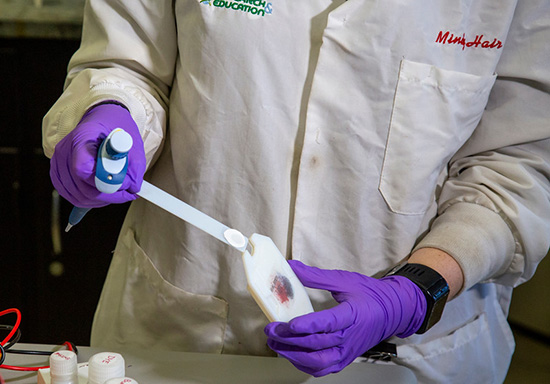Forensic Chemist Proposes Sweat Testing Strip as Breathalyzer Replacement
 |
|
The Halámek lab showcases a prototype of its sweat testing strip. (Photo by Scott Freedman)
|
ALBANY, N.Y. (Dec. 19, 2019) – UAlbany forensic chemist Jan Halámek once again has found an innovative use for human sweat – this time to keep drunk drivers off the road.
Halámek and his team of student researchers, led by Department of Chemistry graduate student Mindy Hair, are developing a sensing strip that can detect a person’s blood alcohol content (BAC) based on ethanol levels in a small sweat sample.
According to Halámek, sweat glands are close enough to circulating blood that ethanol can be transferred between the two fluids. His team’s sensing strip would work in a way that is similar to a pregnancy test or glucometer. When the strip is placed against the skin of a suspected intoxicated individual, any ethanol present produces a visible color spot. The darker the color spot, the more alcohol in the system.
The strip triggers an enzymatic cascade – a sequence of successive biochemical reactions involving enzymes – that is optimized to test for ethanol levels in sweat.
Proof of Concept
As a proof of concept, the Halámek lab was approved to lead a controlled drinking study with 26 volunteers. After providing a sweat sample to prove sobriety, the volunteers consumed several shots of 40 percent vodka to obtain .08 percent BAC. Over the next few hours, more than 100 readings were compared between a professional grade breathalyzer and the sensing strip.
The sweat samples showed a strong correlation with the breathalyzer readings. Findings were published in Analytical Chemistry.
.jpg) |
|
Mindy Hair (left) is leading a team of student researchers in the Halámek lab to develop the sweat testing strip. (Photo by Scott Freedman) |
“There’s a direct relationship between ethanol in blood and sweat,” said Halámek, an assistant professor of chemistry. “Through our research, we have shown that as an individual consumes alcoholic beverages, their blood alcohol levels increase at a similar pace to sweat alcohol levels. This finding could have significant implications for law enforcement to assess and prevent drunk driving.”
Halámek cites that portable breathalyzers have numerous flaws. For example, diabetics can have acetone in their breath that is unrelated to intoxication levels. Mouthwashes, breath fresheners and even vapors in the air from windshield wiper fluid can also inflate BAC readings. Additionally, the test requires breath to be blown for a full 10 seconds before a reading can be made.
The sensing strip would collect data noninvasively and does not require the individual to be conscious to be evaluated. Further, Halámek’s lab is working with the Department of Computer Science to develop a smartphone application that would match the test strip’s color change with BAC level to avoid any discrepancies.
"The breathalyzer test relies on non-specific electrochemical responses to determine the amount of alcohol circulating in blood based on the amount of ethanol in breath. This system is flawed and often not usable in court,” Halámek said. “With less errors, we believe our sensing strip would offer more versatility and accuracy and be applied for legal purposes.”
“Our test can be performed instantaneously by a police officer or the individual before making the decision to get behind the wheel,” he added.
According to Halamek, human sweat can be used for other drug testing as well. His lab also released a study this month in ACS Sensors that analyzed fingerprints from volunteers to measure for THC levels - the main psychoactive component of marijuana. Volunteers willingly disclosed their use of marijuana prior to providing fingerprints.
The Halámek Lab
These latest findings add to a number of its groundbreaking forensics discoveries by the Halámek lab. In 2017, his team released a concept paper for a sweat-based authentication to unlock mobile and wearable devices. The lab has also released numerous studies on the use of physical crime scene evidence, such as fingerprints or blood residue, to quickly identify key characteristics of culprits.
Halámek joined UAlbany in 2013 and has been funded through numerous fellowships and a three-year grant from the Department of Justice and National Institute of Justice to develop non-invasive sensing concepts. Their goal is to create a field kit for law enforcement use.
You can learn more about Halámek by visiting his research website and expert page.
![]() For more news, subscribe to UAlbany's RSS headline feeds
For more news, subscribe to UAlbany's RSS headline feeds
A comprehensive public research university, the University at Albany-SUNY offers more than 120 undergraduate majors and minors and 125 master's, doctoral and graduate certificate programs. UAlbany is a leader among all New York State colleges and universities in such diverse fields as atmospheric and environmental sciences, business, education, public health,health sciences, criminal justice, emergency preparedness, engineering and applied sciences, informatics, public administration, social welfare and sociology, taught by an extensive roster of faculty experts. It also offers expanded academic and research opportunities for students through an affiliation with Albany Law School. With a curriculum enhanced by 600 study-abroad opportunities, UAlbany launches great careers.


